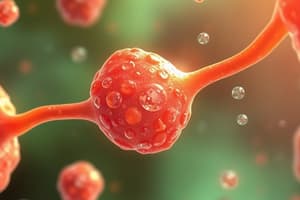Podcast
Questions and Answers
What are the primary bile salts?
What are the primary bile salts?
- Ursodeoxycholic acid, glycine, chenodeoxycholic acid, deoxycholic acid
- Cholic acid, taurine, deoxycholic acid, lithocholic acid
- Cholic acid, chenodeoxycholic acid, deoxycholic acid, lithocholic acid (correct)
- Ursodeoxycholic acid, chenodeoxycholic acid, taurine, deoxycholic acid
How are sulfated bile salts formed?
How are sulfated bile salts formed?
- By bacterial transformation of primary bile salts
- Through enzymatic reactions (correct)
- By addition of phosphate groups
- Through chemical processes
Which process results in the formation of secondary bile salts?
Which process results in the formation of secondary bile salts?
- Chemical modification
- Bacterial transformation of primary bile salts (correct)
- Conversion to glycogen
- Addition of sulfate groups
Which compound is formed from the bacterial transformation of cholic acid?
Which compound is formed from the bacterial transformation of cholic acid?
What is the role of bile salts in digestion?
What is the role of bile salts in digestion?
What can excessive retention of bile salts lead to?
What can excessive retention of bile salts lead to?
What did a study on gallbladder cancer patients find regarding deoxycholic acid?
What did a study on gallbladder cancer patients find regarding deoxycholic acid?
How can probiotics help in reducing the risk of developing gallstone disease?
How can probiotics help in reducing the risk of developing gallstone disease?
What is the potential benefit of modifying bile salts to make them less toxic?
What is the potential benefit of modifying bile salts to make them less toxic?
In what field have researchers explored the use of bile salts as possible pollution indicators?
In what field have researchers explored the use of bile salts as possible pollution indicators?
How can bile salt modifications contribute to detecting diseases?
How can bile salt modifications contribute to detecting diseases?
What does further research in understanding bile salt modifications promise?
What does further research in understanding bile salt modifications promise?
Flashcards are hidden until you start studying
Study Notes
Introduction
Bile salts are amphipathic molecules synthesized by the liver from cholesterol, taurine, and glycine or glycolate. They play significant roles in digestion, including emulsification of lipids and absorption of fatty acids, vitamins, and essential minerals. However, excessive production or retention can lead to health issues such as gallstones and gastrointestinal disorders. This article will delve into the modifications made to bile salts, their importance, and potential applications.
Bile Salt Modifications
The primary bile salts are cholic acid, chenodeoxycholic acid, deoxycholic acid, lithocholic acid, and ursodeoxycholic acid. These compounds can be modified through metabolic pathways, enzymatic reactions, or through chemical processes. One notable modification is the addition of sulfate groups to primary bile salts, resulting in sulfated bile salts. Sulfated bile salts have been identified in human bile, suggesting they may be involved in physiological functions beyond those typically associated with primary bile salts.
Another modification involves the formation of secondary bile salts through bacterial transformation of primary bile salts. Secondary bile salts are formed when bacteria hydrolyze primary bile salts, breaking down ester bonds between the steroid nucleus and the carboxylic acid group. For example, conversion of cholic acid to deoxycholic acid occurs via this mechanism.
Modifications to bile salts can also occur due to diseases like gallbladder cancer. In a study on gallbladder cancer patients, it was found that the abundance of deoxycholic acid increased significantly compared to healthy controls. This suggests that changes in bile salt composition could serve as biomarkers for early detection of certain types of cancer.
Applications of Bile Salt Modifications
Understanding the mechanisms behind bile salt modifications has led to the development of probiotics capable of hydrolyzing bile salts in the gut. These probiotics can help reduce the risk of developing gallstone disease and other related complications. Additionally, modifying bile salts to make them less toxic can potentially alleviate side effects associated with conventional treatment methods for gallstones.
In the field of environmental science, researchers have explored the use of bile salts as possible indicators of pollution. By analyzing the ratios of different bile salts present in wildlife species, scientists can evaluate the levels of contamination in aquatic environments.
Conclusion
Bile salt modifications play crucial roles in maintaining health and detecting disease. Understanding these processes can open doors to new treatments and biomarkers. Further research in this area holds promise for advancing our knowledge of bile salts and their impact on health and ecology.
Studying That Suits You
Use AI to generate personalized quizzes and flashcards to suit your learning preferences.




